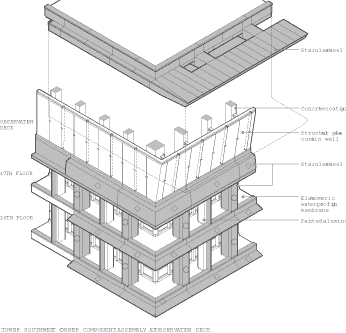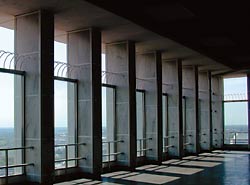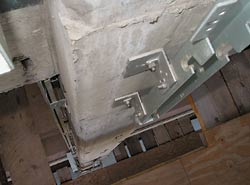Born Again: A New Skin Offers a Fresh Start
The problem
The thin marble veneers that cover the entire structure were the problem. Microscopically, certain marbles are composed of a series of tightly interlocked, crystalline calcite grains that are adhered together with a calcite binder. Changes in temperature reek havoc on this type of structure by causing intergranular fractures, or microcracking, in the calcite binder. The grains within the binder "disassociate," meaning they come apart. This constitutes a permanent change in the material properties of the marble, which causes a volumetric expansion. And the march toward deterioration begins. This condition is known as hysteresis, and it's as bad as it sounds.
|
Hysteresis is especially threatening to thin marble veneers, a popular cladding material in the 1970s. Not only are the panels of Georgia white marble on the city hall thin, they have a coarse grain, which makes them more prone to hysteresis than fine-grain marbles, such as Vermont marble.
In hysteresis, individual panels will deteriorate at different rates, depending on the extent of exposure to temperature changes. Obviously, the exterior faces, which are exposed to sunlight and weathering, will experience hysteresis more than the protected, interior areas. Because the exterior surfaces therefore deteriorate faster, the panels will cup and bow outward. Severe weathering will cause visible cracking at the panel edges. As the bowing gets worse, moisture penetration increases, and the cracks in the exposed panel surfaces open up more.
|
In cities, acid rain can accelerate the dissolving of the calcite binder, which increases the rate of disaggregation of the stone. Disaggregation is also known as "sugaring," due to the loose, powdery calcite grains that appear on the exposed surfaces when this happens. This leads to more edge-cracking and distress within the panels, which, in turn, leads to significant strength loss in the stone.
|
For the past 30 or 40 years, hysteresis has been acknowledged as a serious condition affecting marble, but its effect on thin stone veneers was not widely known at the time Richmond City Hall was designed and built. Today, it is generally accepted that hysteresis is what might be called a terminal disease for thin marble veneers, since it can neither be reversed nor cured. Once the disease has reduced the flexible strength of a marble panel to between 400 and 600 psi (1,000 psi is the current minimum industry standard), the structural integrity of the stone has probably been forever lost, and in situ repair or stabilization is no longer a viable option. Eventually, the panel will become so fragile that it will become dangerous to leave it on the building. This was the case with Richmond City Hall, as the SMBW and WJE study reported.













